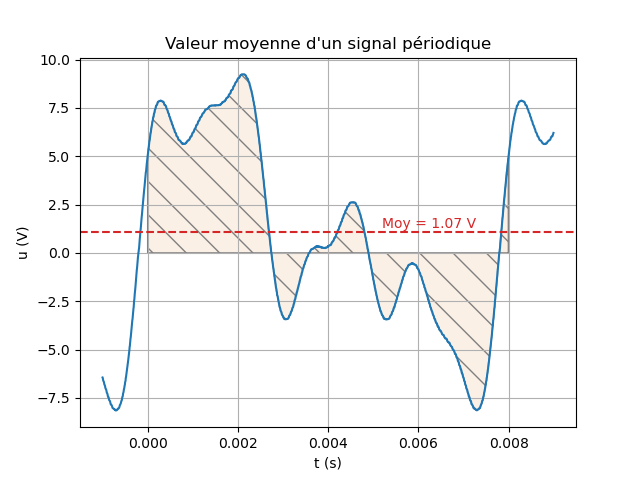Librairie Python pour la physique appliquée
Project description
Librairie Python pour la physique appliquée
Installation
Dans un terminal :
pip install physapp
Mise à jour :
pip install --upgrade physapp
Dépendances
Cette librairie se base principalement sur les librairies numpy (>= 1.26.0) , matplotlib (>= 3.8.0) et scipy (>= 1.11.0).
Module physapp.base
> Fonctions disponibles
derive(y, x)
integrale(y, x, xinf, xsup)
spectre_amplitude(y, t, T)
spectre_RMS(y, t, T)
spectre_RMS_dBV(y, t, T)
> Exemple
import numpy as np
import matplotlib.pyplot as plt
from physapp import integrale
### IMPORTATION DES DONNEES ###
t, u = np.loadtxt('scope.csv', delimiter=',', skiprows=2, unpack=True)
### CALCULS ###
f = 125
T = 1/f
aire = integrale(u, t, 0, T, plot_ax=plt)
moy = aire/T
### COURBES ###
plt.plot(t, u)
plt.axhline(moy, ls="--", color="C3")
plt.text(0.65*T, moy+0.2, "Moy = {:.2f} V".format(moy), color="C3")
plt.title("Valeur moyenne d'un signal périodique")
plt.xlabel("t (s)")
plt.ylabel("u (V)")
plt.grid()
plt.show()
Module physapp.modelisation
Fonctions pour réaliser une modélisation d'une courbe expérimentale.
> Fonctions classiques
| Fonction | Description |
|---|---|
ajustement_lineaire(x, y) |
$y=a\cdot x$ |
ajustement_affine(x, y) |
$y=a\cdot x+b$ |
ajustement_parabolique(x, y) |
$y=a\cdot x^2+b\cdot x+c$ |
ajustement_exponentielle_croissante(x, y) |
$y=A\cdot(1-e^{-x/\tau})$ |
ajustement_exponentielle_decroissante(x, y) |
$y = A\cdot e^{-x/\tau}$ |
ajustement_exponentielle2_croissante(x, y) |
$y = A\cdot(1-e^{-kx})$ |
ajustement_exponentielle2_decroissante(x, y) |
$y = A\cdot e^{-kx}$ |
ajustement_puissance(x, y) |
$y=A\cdot x^n$ |
> Réponses fréquentielles
ajustement_ordre1_passe_bas_transmittance(f, T)
ajustement_ordre1_passe_bas_gain(f, G)
ajustement_ordre1_passe_bas_dephasage(f, phi)
ajustement_ordre1_passe_haut_transmittanc(f, T)
ajustement_ordre1_passe_haut_gain(f, G)
ajustement_ordre1_passe_haut_dephasage(f, phi)
ajustement_ordre2_passe_bas_transmittance(f, T)
ajustement_ordre2_passe_haut_transmittance(f, T)
ajustement_ordre2_passe_haut_dephasage(f, phi)
ajustement_ordre2_passe_bande_transmittance(f, T)
ajustement_ordre2_passe_bande_gain(f, G)
ajustement_ordre2_passe_bande_dephasage(f, phi)
> Exemple
import matplotlib.pyplot as plt
from physapp.modelisation import ajustement_parabolique
x = [0.003,0.141,0.275,0.410,0.554,0.686,0.820,0.958,1.089,1.227,1.359,1.490,1.599,1.705,1.801]
y = [0.746,0.990,1.175,1.336,1.432,1.505,1.528,1.505,1.454,1.355,1.207,1.018,0.797,0.544,0.266]
modele = ajustement_parabolique(x, y)
print(modele)
plt.plot(x, y, '+', label="Mesures")
modele.plot() # Trace la courbe du modèle
#modele.legend() # Affiche la légende du modèle
plt.legend()
plt.title("Trajectoire d'un ballon")
plt.xlabel("x (m)")
plt.ylabel("y (m)")
plt.grid()
plt.show()
Résultat :
Fonction parabolique
y = a*x^2 + b*x + c
a = (-1.25 ±0.060)
b = (2.04 ±0.11)
c = (0.717 ±0.045)
Intervalle de confiance à 95% sans incertitudes sur x et y.
Module physapp.csv
Module d'importation de tableau de données au format CSV à partir des logiciels Aviméca3, Regavi, ...
> Fonctions disponibles
load_txt(fileName)
load_avimeca3_txt(fileName)
load_regavi_txt(fileName)
load_regressi_txt(fileName)
load_regressi_csv(fileName)
load_oscillo_csv(filename)
load_ltspice_csv(filename)
save_txt(data, fileName)
Project details
Release history Release notifications | RSS feed
Download files
Download the file for your platform. If you're not sure which to choose, learn more about installing packages.













